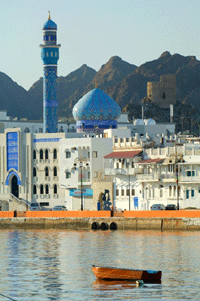
Oman economy outlook good despite risks
Muscat, July 9, 2012
Oman's economy seems to have weathered the first quarter's global slowdown quite well and its 2012 outlook remains positive despite external risks, a central bank (CBO) report showed.
'The growth momentum witnessed in 2011 appears to have sustained in the first quarter of 2012 notwithstanding deteriorating global macroeconomic conditions, arising mainly due to (the) sovereign debt crisis in Europe,' said the 2011 annual report.
'The overall outlook for Oman remains positive in 2012 despite heightened downside risks to global recovery,' it added.
The report did not give a specific growth figure for the first quarter. Gross domestic product grew a real 5.5 percent in 2011, according to an International Monetary Fund estimate, after a 5 per cent rise in 2010.
However, Oman may be adversely affected if oil prices fall because of worsening global conditions, the central bank said. In addition, the private sector in the sultanate has yet to regain confidence fully, it said.
'Profits earned by the private sector continue to remain sluggish. This is holding back private investment in Oman despite large government expenditure.'
Oman, which gets about three-quarters of its government revenue from crude oil exports, faced strikes in the oil sector in May and June.
The price of Brent crude plunged $40 to as low as $88 per barrel between March and June but has since recovered to around $98. Oman, where oil and gas account for about half of GDP, sold its crude at an average $103 per barrel in 2011.
'Going forward, the major policy challenge before the CBO is to strike a balance between sustained growth momentum and price stability in Oman,' the report said. 'Reflecting global slowdown, the overall outlook on domestic prices remained benign in the more recent period.'
Annual inflation in the desert country, which has to import essential commodities, eased to a two-year low of 3.0 percent in April from a peak of 5.3 percent in August 2011.
Oman lacks a fully independent monetary policy because its rial currency is pegged to the U.S. dollar. Its central bank has been keeping a loose policy stance since early 2009 as inflation slowed sharply from double-digit rates seen in 2008.
'There is scope for the CBO and the government to pursue accommodative monetary and fiscal policies in the rest of 2012 without jeopardising macroeconomic stability of Oman,' it added.
The interest rate which it uses to drain excess liquidity from the market has stood at around 0.08 percent at its weekly auctions of deposit certificates.
'There may be pressure on the exchange rate if the inflation rate differential between Oman and the U.S. widens further,' the central bank said.
Despite a budgeted fiscal deficit of 1.2 billion rials ($3.1 billion) in 2012, the government balance may turn out to be in surplus in 2012 given still-robust oil prices, the report said.
Any shortfall is expected to be financed partly by drawing from reserves, the surplus from the previous year, and issuance of government development bonds, it said.
The central bank also said unemployment in Oman was 'the single most important problem the country currently faces', but did not provide figures.
The IMF said in December that a 2010 census had put the unemployment rate among Omanis at 24.4 percent, although the high number may include many who are not truly looking for work. Omanis accounted for only 14 percent of nearly 1.3 million private sector employees in 2011, the central bank report showed.-Reuters







